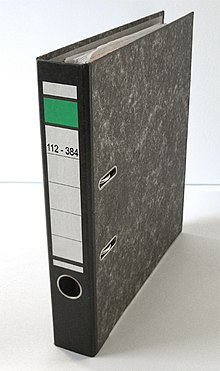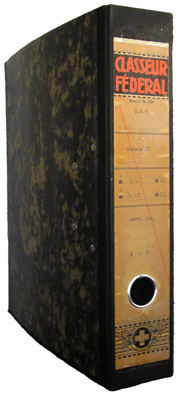
ISO 216 is an international standard for paper sizes, used around the world except in North America and parts of Latin America. The standard defines the "A", "B" and "C" series of paper sizes, which includes the A4, the most commonly available paper size worldwide. Two supplementary standards, ISO 217 and ISO 269, define related paper sizes; the ISO 269 "C" series is commonly listed alongside the A and B sizes.

An envelope is a common packaging item, usually made of thin, flat material. It is designed to contain a flat object, such as a letter or card.

Paper size standards govern the size of sheets of paper used as writing paper, stationery, cards, and for some printed documents.
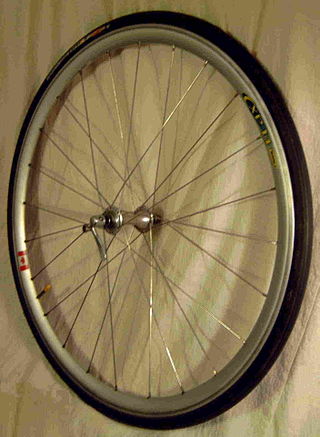
A bicycle wheel is a wheel, most commonly a wire wheel, designed for a bicycle. A pair is often called a wheelset, especially in the context of ready built "off the shelf" performance-oriented wheels.

A perforation is a small hole in a thin material or web. There is usually more than one perforation in an organized fashion, where all of the holes collectively are called a perforation. The process of creating perforations is called perforating, which involves removing bits of the workpiece with a tool. Old-fashioned lick-and-stick postage stamps are perforated. When a tool makes small cuts in the material it is called 'rouletting', because that tool often resembles a roulette wheel, with blades around the edge. Raffle tickets are a good example of rouletting.
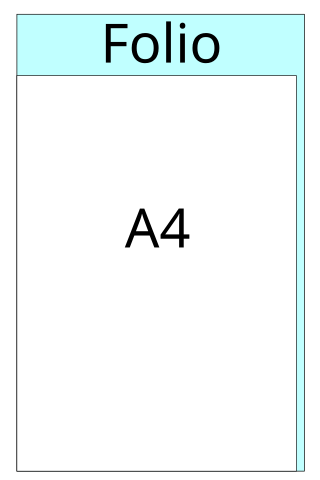
Foolscap folio, commonly contracted to foolscap or cap or folio and in short FC, is paper cut to the size of 8.5 × 13.5 in for printing or to 8 × 13 in for "normal" writing paper (foolscap). This was a traditional paper size used in some parts of Europe, and the British Commonwealth, before the adoption of the international standard A4 paper.

A hole punch, also known as hole puncher, or paper puncher, is an office tool that is used to create holes in sheets of paper, often for the purpose of collecting the sheets in a binder or folder. A hole punch can also refer to similar tools for other materials, such as leather, cloth, or plastic or metal sheets.
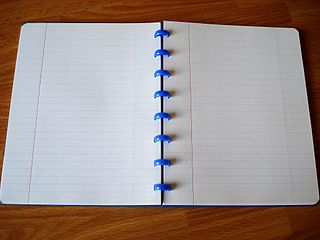
Ruled paper is writing paper printed with lines as a guide for handwriting. The lines often are printed with fine width and in light colour and such paper is sometimes called feint-ruled paper. Additional vertical lines may provide margins, act as tab stops or create a grid for plotting data; for example, graph paper is divided into squares by horizontal and vertical lines.
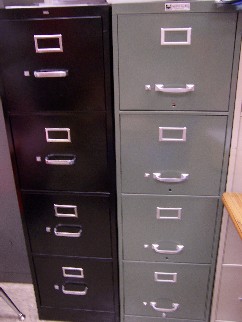
A filing cabinet is a piece of office furniture for storing paper documents in file folders. In the most simple context, it is an enclosure for drawers in which items are stored. The two most common forms of filing cabinets are vertical files and lateral files. A vertical file cabinet has drawers that extend from the short side of the cabinet. A lateral file cabinet has drawers that extend from the long side of the cabinet. These are also called side filers in Great Britain. There are also shelf files which go on shelves. In the United States, file cabinets are usually built to accommodate 8.5 × 11 paper, and in other countries, filing cabinets are often designed to hold other sizes of paper, such as A4 paper.
A loose leaf is a piece of paper of any kind that is not bound in place, or available on a continuous roll, and may be punched and organized as ring-bound or disc-bound. Loose leaf paper may be sold as free sheets, or made up into notepads, where perforations or glue allow them to be removed easily. "Leaf" in many languages refers to a sheet or page of paper, as in Folio, as in feuille de papier (French), hoja de papel (Spanish), foglio di carta (Italian), and ルーズリーフ.
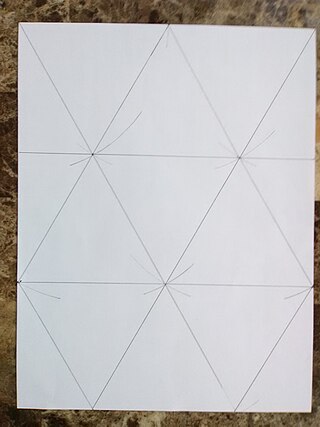
Letter or ANSI Letter is a paper size standard defined by the American National Standards Institute, commonly used as home or office stationery in the United States, Canada, Chile, Colombia, Costa Rica, Mexico, Panama, Guatemala, the Dominican Republic and the Philippines. It measures 8.5 by 11 inches and is similar in use to the A4 paper standard at 210 mm × 297 mm used by most other countries, defined in ISO 216 by the International Organization for Standardization.

A file folder is a kind of folder that holds papers together for organization and protection. File folders usually consist of a sheet of heavy paper stock or other thin, but stiff, material which is folded in half, and are used to keep paper documents. They are often used in conjunction with a filing cabinet for storage. File folders can easily be purchased at office supplies stores.
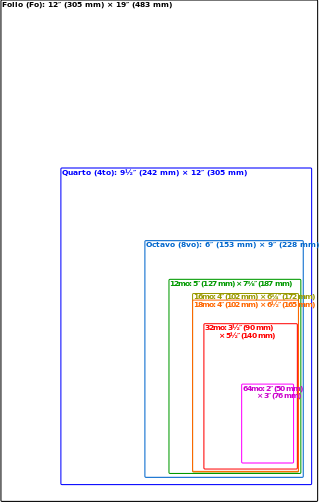
The size of a book is generally measured by the height against the width of a leaf, or sometimes the height and width of its cover. A series of terms is commonly used by libraries and publishers for the general sizes of modern books, ranging from folio, to quarto (smaller) and octavo. Historically, these terms referred to the format of the book, a technical term used by printers and bibliographers to indicate the size of a leaf in terms of the size of the original sheet. For example, a quarto historically was a book printed on sheets of paper folded in half twice, with the first fold at right angles to the second, to produce 4 leaves, each leaf one fourth the size of the original sheet printed – note that a leaf refers to the single piece of paper, whereas a page is one side of a leaf. Because the actual format of many modern books cannot be determined from examination of the books, bibliographers may not use these terms in scholarly descriptions.
Paper drilling is a technique used in trade binderies for providing large quantities of paper with round holes. The paper can be processed as loose leaves and in brochures. The holes usually serve storage purposes, such as filing, although sometimes also for decorative purposes.

An exercise book or composition book is a notebook that is used in schools to copy down schoolwork and notes. A student will usually have different exercise books for each separate lesson or subject.
Grammage and basis weight, in the pulp and paper industry, are the area density of a paper product, that is, its mass per unit of area. Two ways of expressing grammage are commonly used:

Comb binding is one of many ways to bind pages together into a book. This method uses round plastic spines with 19 rings or 21 rings and a hole puncher that makes rectangular holes. Comb binding is sometimes referred to as plastic comb binding or spiral comb binding.
Standard photographic print sizes are used in photographic printing. Cut sheets of paper meant for printing photographs are commonly sold in these sizes.
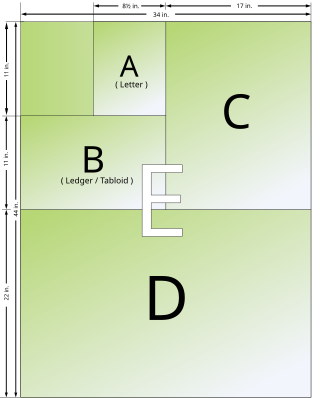
In 1992, the American National Standards Institute adopted ANSI/ASME Y14.1Decimal Inch Drawing Sheet Size and Format, which defined a regular series of paper sizes based upon the de facto standard 8+1⁄2 in × 11 in "letter" size to which it assigned the designation "ANSI A". This series also includes "ledger"/"tabloid" as "ANSI B". This series is somewhat similar to the ISO 216 standard in that cutting a sheet in half would produce two sheets of the next smaller size. Unlike the ISO standard, however, the arbitrary aspect ratio forces this series to have two alternating aspect ratios. ANSI/ASME Y14.1 has been revised or updated in 1995, 2005, 2012 and 2022. It had an accompanying standard, ANSI/ASME Y14.1M, that defined metric drawing paper sizes based upon ISO 216 and ISO 5457. ASME Y14.1 and ASME Y14.1M have now been revised and consolidated into one document, ASME Y14.1-2020, Drawing Sheet Size and Format, published on 18 December 2020.

Bookbinding is the process of building a book, usually in codex format, from an ordered stack of paper sheets with one's hands and tools, or in modern publishing, by a series of automated processes. Firstly, one binds the sheets of papers along an edge with a thick needle and strong thread. One can also use loose-leaf rings, binding posts, twin-loop spine coils, plastic spiral coils, and plastic spine combs, but they last for a shorter time. Next, one encloses the bound stack of paper in a cover. Finally, one places an attractive cover onto the boards, and features the publisher's information and artistic decorations.
